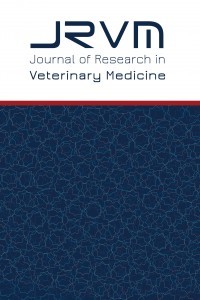Prevalence of Nosema ceranae in North and South Regions of Azerbaijan
Prevalence of Nosema ceranae in North and South Regions of Azerbaijan
Nosema ceranae, prevalence, honey bee, Azerbaijan,
___
- 1. Anonymous. Azerbaijan Food Balances-2019. The Food and Agriculture Organization (FAO) Reports, FAOSTAT. https://www.fao.org/faostat/en/#data/FBS. Accessed April 21, 2022.
- 2. Aydın L, Gülegen E, Cakmak I, et al. Relation between nosema and chalkbrood diseases, and its implication for an apiary management model. Bull Vet Inst Pulawy. 2006; 50: 471-475.
- 3. Fries I. Nosema ceranae in European honeybees (Apis mellifera). J Inverteb Pathol. 2010; 103: 73–79.
- 4. Forsgren E, Fries I. Comparative virulence of Nosema ceranae and Nosema apis in individual European honey bees. Vet Parasitol. 2010; 170: 212-217.
- 5. Higes M, Martin-Hernandez R, Garrido-Bailon E, et al. Detection of infective Nosema ceranae (Microsporidia) spores in corbicular pollen of forager honeybees. J Inverteb Pathol 2008; 97: 76-78.
- 6. Higes M, Martín-Hernández R, Garrido-Bailón E, et al. The presence of Nosema ceranae (Microsporidia) in African Honey bees (Apis mellifera intermissa). J Apic Res. 2009; 48: 217–219.
- 7. Huseynov H, Rustamli Y. In the condition of Nakhchivan Autonomous Republic the dependence of infection rate of honey bees with Nosema parasite on the strength of colony and the season of the year. III. Nakhchivan International Beekeeping Conference, 2017, Congress book p. 11-15.
- 8. Huseynov HT. Bio-ecological characteristics of Nosema parasite (Nosema apis Z.) in honey bees of Nakhchivan AR, curative and prophylactic actions for it: biology candidate of sciences. Dissertation synopsis of thesis: 03.00.19; The Zoology Institute of ANAS - Baku, Azerbaijan. 2006. - 20 p.
- 9. Gurgulova K, Valchovski R, Petrov P, et al. Distribution of Nosema apis and Nosema ceranae in Bulgaria. Diagnostic in honey bees. From sampling to data analyses. Beedoc-Cost Action. 2010; Ghent University, Belgium.
- 10. Klee J, Besana AM, Genersch E, et al. Widespread dispersal of the microsporidian Nosema ceranae, an emergent pathogen of the western honey bee, Apis mellifera. J Inverteb Pathol. 2007; 96: 1–10.
- 11. Martín-Hernández R, Meana A, Prieto L, et al. Outcome of colonization of Apis mellifera by Nosema ceranae. Appl Environ Microbiol. 2007; 73: 6331–6338.
- 12. Mohammadian B, Bokaie S, Moharrami M, et al. Distribution of Nosema spp. in climatic regions of Iran. Vet Res Forum. 2018; 9(3): 259 – 263.
- 13. Neumann P, Carreck NL. Honey bee colony losses. J Apic Res. 2010; 49(1): 1-6.
- 14. Paxton R, Klee J, Korpela S, et al. Nosema ceranae has infected Apis mellifera in Europe since at least 1998 and maybe more virulent than Nosema apis. Apidologie. 2007; 38: 558–565.
- 15. Razmaraii N, Sadigh-Eteghad S, Babaei H, et al. Molecular identification of Nosema species in East Azerbaijan province, Iran. Arch Razi Inst. 2013; 68(1): 23–27.
- 16. Tahirov A, Huseynov H. Nahcivan Özerk Cumhuriyetinde erken ilkbaharda arı kolonilerinin Nosema apis ile enfeksiyon derecesine göre gelişme durumları. In: Proceedings of 17th National Parasitology Congress and Caucasian and Middle East Symposium on Parasitic Diseases, Kars, Turkey, 4–10 September 2011, p. 319.
- 17. Ütük AE, Aliyeva R, Girisgin AO, et al. First molecular detection of Nosema ceranae in Azerbaijan. J Apic Res. 2019; 58(4): 559-561.
- 18. Shimunaki H, Knox DA. Laboratory diagnosis of honey bee diseases. US Department of Agriculture, Technical Bulletin, 1990.
- 19. Alaux C, Folschweiller, McDonnell M, et al. Pathological effects of the microsporidium Nosema ceranae on honey bee queen physiology (Apis mellifera). J Inverteb Pathol. 2011; 106: 380-385.
- Başlangıç: 1981
- Yayıncı: Bursa Uludağ Üniversitesi
Metin PETEK, Ibrahima Mahamane ABDOURHAMANE, Fahir Cankat BRAV, Cihan ÜNAL
Ceren ANLAŞ, Tülay BAKIREL, Ufuk Koca ÇALIŞKAN, Ceylan DÖNMEZ, Fulya ÜSTÜN ALKAN, Oya ÜSTÜNER KELEŞ
Gizem AYTOĞU, Kadir YEŞİLBAĞ, Eda Baldan TOKER, Berfin KADİROĞLU, Özer ATEŞ, Pelin TUNCER-GÖKTUNA
Barış GÜNER, İhsan KISADERE, Hakan TAVŞANLI, Serpil KAHYA DEMİRBİLEK, Abdulkadir KESKİN
Neonatal buzağı ishal olgularında enterik virusların (BRV, BCoV, BVDV, BToV) çoklu enfeksiyonu
Promising effects of vinasse use on bone strength in laying hens.
Bayram SÜZER, Gülsüm EREN, Kerem ATAMAY
Prevalence of Nosema ceranae in North and South Regions of Azerbaijan
Ahmet Onur GİRİŞGİN, Rafiga GAZİ, Barat AHMEDOV, Armağan Erdem ÜTÜK, Levent AYDIN
Effect of Intravenously Injected Arachidonic Acid on Electrocardiography in Rats
